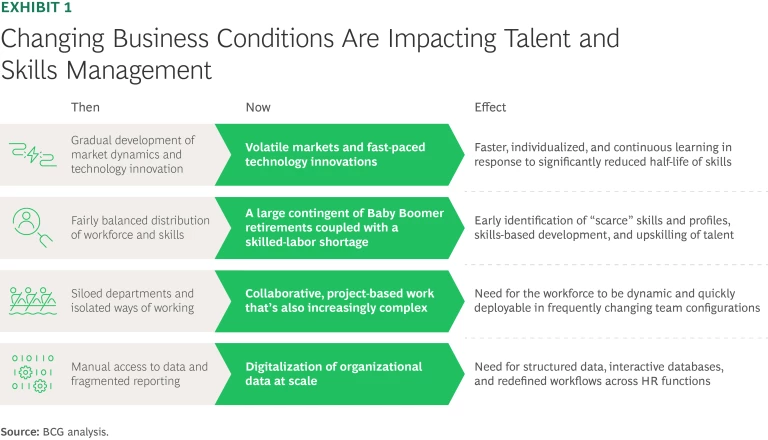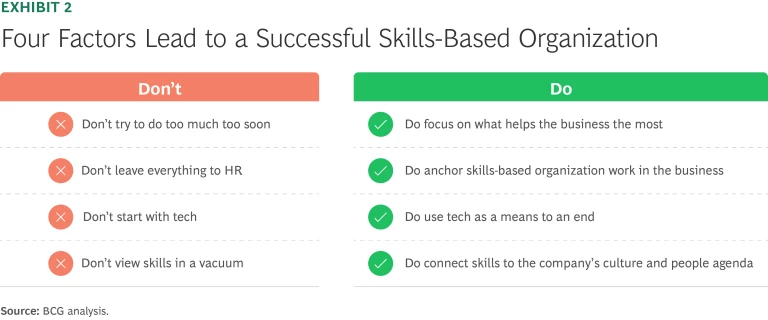It’s been close to a decade since technology companies started removing university and college degree requirements from some job ads, the first sign that skills were becoming more important than credentials as an indicator of ability. That approach, which began as a way to hire software developers, has expanded to companies and positions of all kinds as more businesses attempt to create a skills-based organization.
The trend comes as job roles and capabilities are being disrupted and reconfigured due to faster-paced economic and market changes, global uncertainties, and technological innovation fueled by AI and GenAI in particular. By cultivating a skills-based organization where people can constantly learn and redeploy new abilities as needed, companies can maximize flexibility and adapt quickly to shifting business demands. They can also buffer the effects of ongoing talent shortages and future-proof their workforce.
By cultivating a skills-based organization where people can constantly learn and redeploy new abilities as needed, companies can maximize flexibility and adapt quickly to shifting business demands.
But efforts often go sideways and fall short of realizing tangible benefits. We’ve found that initiatives to create skills-based organizations often aren’t well conceived, don’t build on each other, or don’t support broader workforce planning or a company’s strategic goals. They can be difficult to scale and impossible to sustain because they aren’t grounded in what’s important to the business. Or they turn out to be more hype than substance.
Despite the challenges, companies can have positive outcomes if they take a thoughtful, methodical approach to building a skills-based organization that incorporates certain success factors. Part of that includes designing use cases that build on each other and assembling cross-functional teams to launch pilots that deliver results.
A Solution for Tumultuous Times
Companies are redesigning their people strategies to be more skills based in order to respond to dynamic business conditions, competition, and talent shortages. But that’s not all. The workforce has evolved. (See Exhibit 1.) The average half-life of skills is now less than five years—and in some tech fields, it’s half of that. At many organizations, people don’t have the capabilities they need to use new tools that they’re being asked to adopt in their work, most prominently GenAI tools like ChatGPT.

Stay ahead with BCG insights on people strategy
Companies launch skills-based organization initiatives to address those shortcomings. The initiatives could include developing a skills taxonomy, a structured inventory of the skills that are most relevant to what the company needs, and a strategic skills plan, an outline of how the company can acquire those skills. They could include identifying gaps that upskilling or reskilling programs could target and then launching personalized learning programs to help people improve in those areas or develop alternative career paths. They could also include figuring out how to retain nontraditional talent—those who follow more unconventional paths to obtain desired skills, such as teaching themselves, learning on the job, or attending coding bootcamps instead of college.
Why Skills-Based Initiatives Fail
Despite good intentions, we know from client work that such undertakings often fall short because of flaws in how they’re set up and executed. Some of the most common shortcomings include the following:
Lack of Planning. Companies may fail to give themselves enough time to translate business strategy into a strategic skills plan. Between identifying skills gaps and recruiting to fill them and launching upskilling or mobility programs, this process may take three to five years.
Without a skills-based strategic plan, there’s no way to know which abilities are becoming obsolete and which the business will need more of in the future.
Isolated Use Cases. Companies often launch use cases that aren’t related to or don’t build on each other or that aren’t connected to HR activities that support the broader business strategy. A company may launch skills-based upskilling or reskilling pilots without doing a meaningful pilot of a skills-based strategic plan first. But without a skills-based strategic plan, there’s no way to know which abilities are becoming obsolete and which the business will need more of in the future. This could lead the business to recruit for roles that aren’t needed rather than for those that are.
Lack of Integration Throughout the Employee Life Cycle. Companies sometimes launch a skills-based organization initiative that addresses a single point in the employee life cycle—they switch to skills-based recruiting, for example. But changing a single step in the employee life cycle, even at scale, isn’t enough to create the intended enterprise-wide results.
Lack of Business Involvement. A company’s HR function may lead a skills-based organization initiative without input or buy-in from the business. When that happens, initiatives may not support what the business needs. Or they may never be accepted and integrated into the company’s routine functions.
Four Success Factors to Overcome Challenges
We’ve identified four success factors that can help companies overcome common barriers to skills-based organization initiatives. (See Exhibit 2.)

Focus on what helps the business the most. Skills-based organization initiatives are successful when companies resist the urge to do too much too soon. They create a strategic skills plan and launch an end-to-end skills-based organization on a trial basis in a subset of the company—such as in a single business unit—where they know they can achieve quick wins that will create measurable impact and value before rolling out an initiative at scale. Ideal initial use cases typically have an easy-to-describe skills taxonomy—for example, in IT, where coding languages are well established, or in R&D with specific engineering skills. Promising initial use cases also typically have business department leaders on board who have a strong strategic stake in making a skills-based organization work or who understand the skills evolution and importance of a future-ready workforce as a driver of business success.
A Middle Eastern petrochemical company determined that it needed to level up its workforce capabilities to support its strategic plan for 2030. The areas targeted for improvement included strategic skills planning, skills assessments and proficiency, as well as career paths and learning and development. The company started out by launching a skills-based organization pilot in a representative business unit to learn from and scale accordingly. The pilot allowed the company to create an enterprise-wide skills library, standardize skills and proficiencies for hundreds of job clusters, identify skills gaps, and calculate workforce supply and demand through 2030. By improving staffing, output per employee grew by more than 30%.
Taking a phased approach lets a company identify and monitor a few key parameters—such as the rate at which people are reskilling or the efficiencies they gain, or the portion of the workforce with a specific skill in the company’s skill library—that are representative of what’s at stake. This helps leaders determine if the program is creating the expected value. Launching only a few initial use cases gives a company space to design a skills-based organization scheme with enough flexibility that, when the time is right, it can be scaled to cover more departments, business units, or even the entire organization.
Anchor skills-based organization work in the business. HR may be the primary function that oversees the workforce, but successful skills-based organizations are grounded in a company’s overall business strategy, goals, and workforce plan. Launching an initiative for its own sake is a recipe for failure. Successful initiatives must meet a clear business demand or objective, which could be to boost innovation, increase agility, or support digital transformation, for example.
The data and analytics function at a major North American food manufacturer launched a skills-based organization initiative to help their workforce gain the pivotal skills needed to stay competitive and keep up with rapidly shifting consumer behaviors. A cross-functional team of HR, department leaders, and subject matter experts used data and AI to identify the skills that relevant data and analytics job families would need in the future. It then identified existing capabilities and gaps that needed to be filled. The company used the information to pilot a strategic skills plan that helped it pinpoint actions to take in each job family to address gaps. The pilot helped show the company’s data and analytics function how to tailor recruiting assessments to prioritize finding and hiring people with the needed skills and adapt learning and development accordingly.
To work as intended, skills-based organizations need governance structures that balance the needs of the business and HR. That can be accomplished by setting up cross-functional teams with stakeholders from business, HR, and, when applicable, other functions such as operations.
When initiatives are embedded in a company’s strategic plans as well as in the employee life cycle, talent acquisition and learning and development are consistent and synched to overall business goals.
Successful initiatives engage managers and employees early in the process through trainings and incentives. This helps both groups understand and apply the concept of a skills-based approach to their work.
Companies with successful initiatives pencil out the business problem they want to solve and then implement use cases. Only then do they evaluate how AI tools or other technology could support their efforts.
Use tech as a means to an end. With so many companies integrating AI, GenAI, and other new technologies into operations, it would be easy to assume that skills-based organization initiatives should start with tech. But that’s a backwards approach. Tech is an enabler of a skills-based organization, not the starting point. Companies with successful initiatives pencil out the business problem they want to solve or the broader business objectives they want to meet and then implement use cases that are aligned with those goals. Only then do they evaluate how AI tools or other technology could support their efforts. They make certain that the tools they adopt serve those priorities and can be integrated into or seamlessly connect with existing HR and workforce applications, including a company’s HR information system, planning tools, and learning management platform.
One professional services firm wanted to overhaul its talent acquisition process for new hires to address high turnover and attract job candidates from a broader range of educational institutions. The existing selection process wasn’t a reliable predictor of success or evidence based and had other flaws. The firm initiated a skills-based approach by developing a hiring framework to measure candidates’ problem-solving and learning skills against those identified as critical to success. Only then did the company look for tech tools that could analyze candidates’ resumes and proficiencies against desired skills. The new process improved predictability, ensuring better-equipped hires. It also improved the quality of hires, enhanced the candidate experience by making the process more transparent and fair, and ultimately helped the organization better align workers’ capabilities with its long-term workforce strategy.
Companies with successful skills-based organizations make sure that the tech tools they adopt are capable of extending beyond initial use cases and pilot projects to scale across the enterprise. They minimize barriers to adoption by making new technology easy to use for employees, managers, and HR teams. That could mean picking tech tools with intuitive user interfaces, providing upskilling or other training on the tools, or rewarding people for adopting them.
Connect skills to the company’s culture and people agenda. Companies with successful skills-based organizations know tangible value doesn’t come from skills alone. They incorporate support for skills throughout the enterprise: in how leaders are trained, in the collaborative way that work gets done, and into other institutional norms. These companies make skills a part of the culture. They encourage lifelong learning by offering regular upskilling and reskilling through structured and self-directed learning. They encourage internal mobility by supporting career paths that consider a person’s aspirations, experiences, and potential. They encourage cross-functional collaboration to prompt teams to share knowledge.
At the same professional services firm, overhauling the acquisition process for new hires helped the company do a better job of finding people with a growth mindset—those who constantly strive to learn and improve their abilities. This is a critical skill at an enterprise where people must adapt to new circumstances on a regular basis. Instead of structuring incentives to focus on how long people have been on the job, companies with successful skills-based organizations reward people for being adaptable, embracing continuous learning, and making contributions beyond predefined skill sets.
How to Start the Journey
To lay the groundwork for a successful skills-based organization initiative, keep the following considerations in mind:
Have a clearly defined ambition. Determine what you want to achieve and align initiatives with strategic priorities. Identify specific business needs that a skills-based approach can address, such as closing a digital skills gap or improving mobility. To get buy-in from leaders, make sure you can articulate and quantify the expected business impact.
Build a joint HR and business team. Form a cross-functional cohort of leaders and personnel from HR and the business to plan and implement any initiative. This group will select initial pilots in functions where skills are well defined and measurable. They will also develop a skills taxonomy that aligns with business goals and operational realities.
Implement a strategic skills-planning framework. Create a strategic plan to determine demand for and supply of critical skills. Use the plan to identify gaps and design HR measures to fill them, including hiring, reskilling, upskilling, or moving people into different roles. Plans should be granular enough to drive actionable insights but not so detailed that they become impossible to maintain over time
Find tech tools that meet your specific needs. Prioritize easy-to-use AI-based or other solutions that fit current and possible future use cases and that can be integrated with existing HR and business systems.
Foster a company culture that amplifies skills. Promote a culture of continuous learning and adaptability. Encourage leaders to model these principles by embracing skills-based talent decisions. Align incentives and career paths with skills development rather than traditional job roles.
Use what you learn to scale. Use key success metrics, such as talent redeployment efficiency or skills gap closure rates, to measure effectiveness. Use those and other insights gained from pilots to refine frameworks and processes and expand the approach across more business units and use cases. Iterate and make improvements based on employee feedback and the pilots’ impact on the business.
Skills-based organizations are worthy of the buzz they get, but creating them isn’t always easy. Adopting the approach we’ve outlined here can create the solid foundation that companies need to unlock the most value from their efforts.
The authors wish to thank Friederike Fricke, Adriana Dimitriou, and Kim Vagedes for their contributions to this article.






